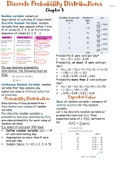Discrete Probability Distributions
Chapter 5
Random variable: numerical
description of outcome of experiment.
Discrete Random Variable: random
variable that may assume either finite
# of values (0, 1, 2, 3, or 4.)/infinite
sequence of values (0, 1, 2, …).
Probability 2 cars sold per day?
▪ 𝑃(𝑥 = 2) = 𝑓(2) = 0.24
Probability, at most, 2 cars sold per
day?
For any discrete probability
▪ 𝑃(𝑥 ≤ 2) = 𝑃(𝑥) = 0 + 𝑃(𝑥=1) + 𝑃 (𝑥=2)
distribution, the following must be
▪ = 𝑓(0) + 𝑓 (1) + 𝑓 (2)
true:
▪ = 0.18 + 0.39 + 0.24 = 0.81
Probability more than 2 cars sold per
day?
Continuous Random Variable: random
▪ 𝑃(𝑥 > 2) = 𝑃(𝑥=3) + 𝑃(𝑥=4) + 𝑃(𝑥=5)
variable that may assume any
▪ = 𝑓 (3) + 𝑓 (4) + 𝑓 (5)
numerical value in interval/collection
▪ = 0.14 + 0.04 + 0.01 = 0.19
of intervals.
Probability Distribution Expected Value
Mean of random variable = measure of
Description of how probabilities =
central location for the random
distributed over values of random
variable.
variable.
Let x be discrete random variable w/
For discrete random variable x,
probability function 𝑓(𝑦). Then
probability function, denoted by f(x),
expected value of x, E(x), defined to
provides probability for each value of
be:
random variable.
E.g. sales of cars past 300 days:
▪ Define random variable: Let 𝑥 = #
of cars sold during day.
▪ Assumption no more than 5 cars
sold per day.
▪ Sample Space: S = {0, 1, 2, 3, 4, 5}




